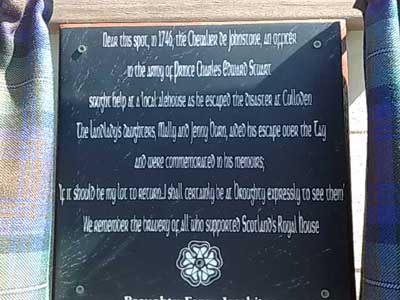|
 |
30-04-2011 Broughty Ferry Plaque unveiling to Chevelier De Johnstone |
The history of the event is one which is not common knowledge compared to others during the 45 uprising. On the front cover of the souvenir booklet which was handed out at the event it is classed as an “Incident of the 45” or “The Chevalier De Johnstone visits a Broughty Ferry Tavern” I suppose it is both, but historians may prefer to choose one or the other. On arriving at the Fishermans Tavern, which was in quite a quiet side street in Broughty Ferry a small crowd had already gathered outside, surrounding a wall mounted plaque veiled with a pair of Jacobite Tartan curtains. I could see the interest this was generating as people passing by stopped to see what was going on. A brief account of the historic event was given by Kevin Cordell who was in period dress for the occasion. This was followed by a few words and the unveiling of the plaque by SNP MSP Stewart Hosie. After the unveiling ceremony had been completed all were invited to the beer garden of the Tavern for refreshment by way of barbeque, all proceeds going to the RNLI. Although a small event in comparison to some others, it was well organised with a mark of quality and organisers should be proud of themselves.
A brief insight to the Chevalier De Johnstone Born in 1719 the time when Jacobitism in Scotland was rife, the son of an Edinburgh merchant with strong Jacobite tendencies it was more than likely that Johnstone would end up fighting for side his father had strong feelings for. When the 45 uprising had began Johnstone was in his twenty’s and became appointed aide de camp to Lord George Murray as well as to The Prince, who immediately after Prestonpans, bestowed upon him the commission of Captain. After Culloden Johnstone was one of those lucky enough to escape the field and being an officer knew his life was in danger and most likely a price on his head, so went into hiding. From Ruthven he headed south via Atholl, Braemar, Glen Prossen ,Forfar and then to Duntrune. Although in hiding he was kept up to date via loyal supporters who also looked after him eventually leading him to Broughty Ferry and the Fishermans Tavern. From this tavern under the cover of darkness he rowed over the Firth of Tay with the aid of the two land lady’s daughters a journey of 2 miles. From there he made his way to Edinburgh, to England then to the safety of Holland. Subsequently he entered the French Army and was sent to Canada where again he acted as aid de camp to the commander. In Canada he again faced the British and again surviving the various conquests he returned to France where he devoted his later year to writing, which include his most notable publication “Memoirs of the 45” James Singer |

|